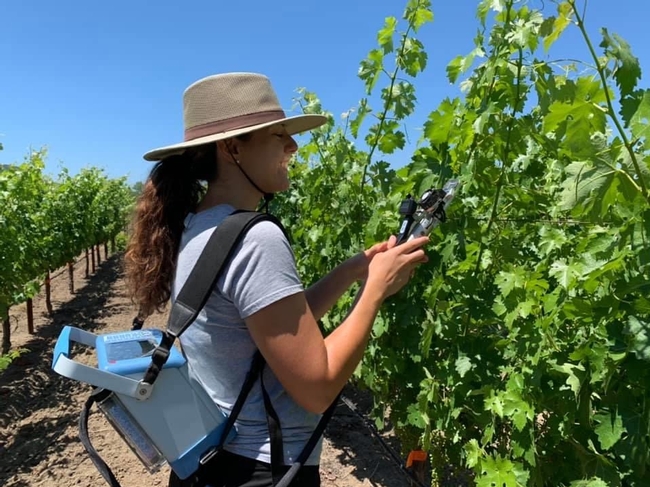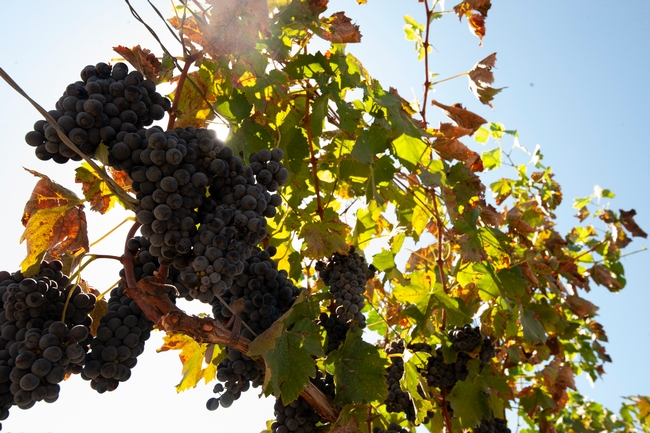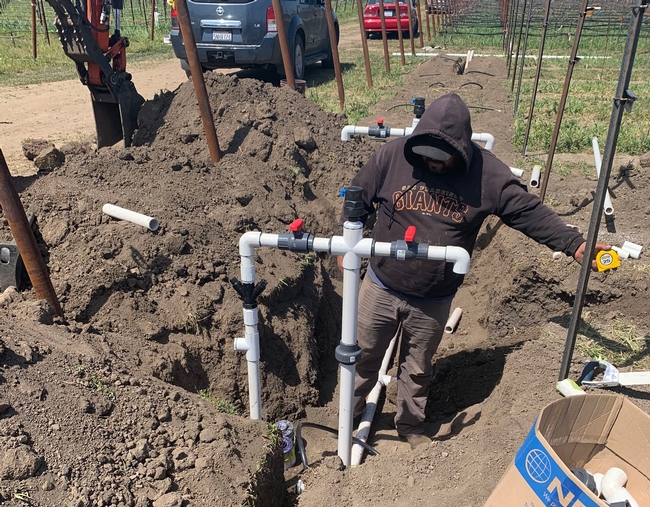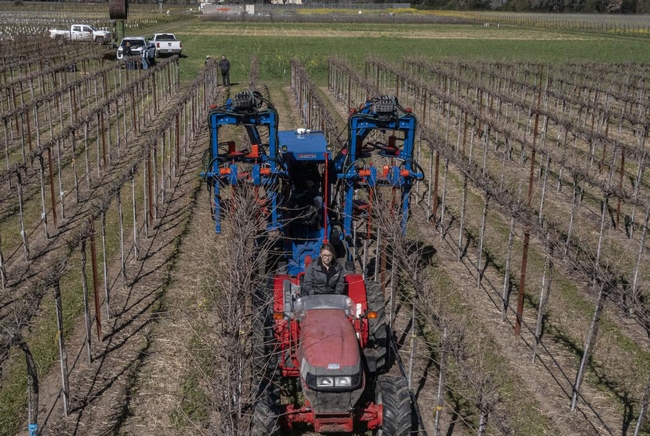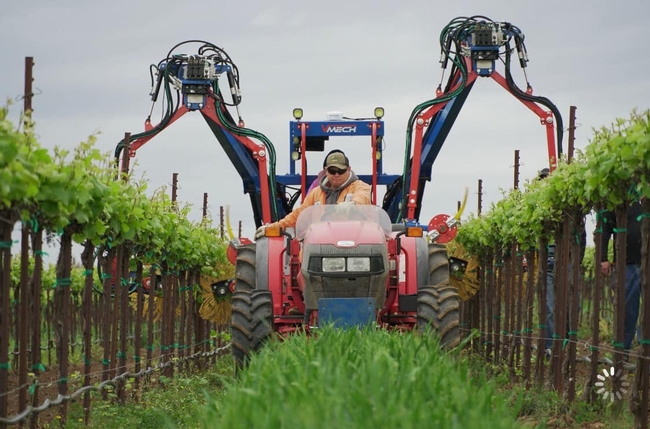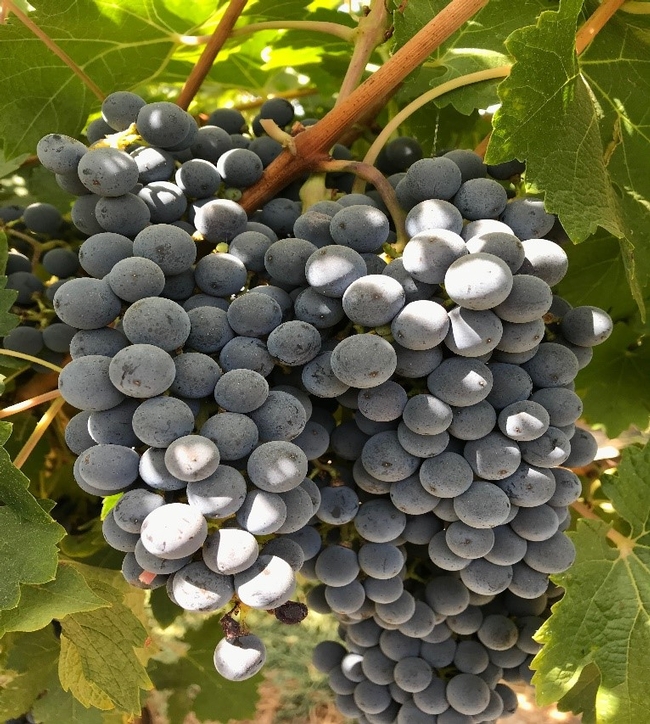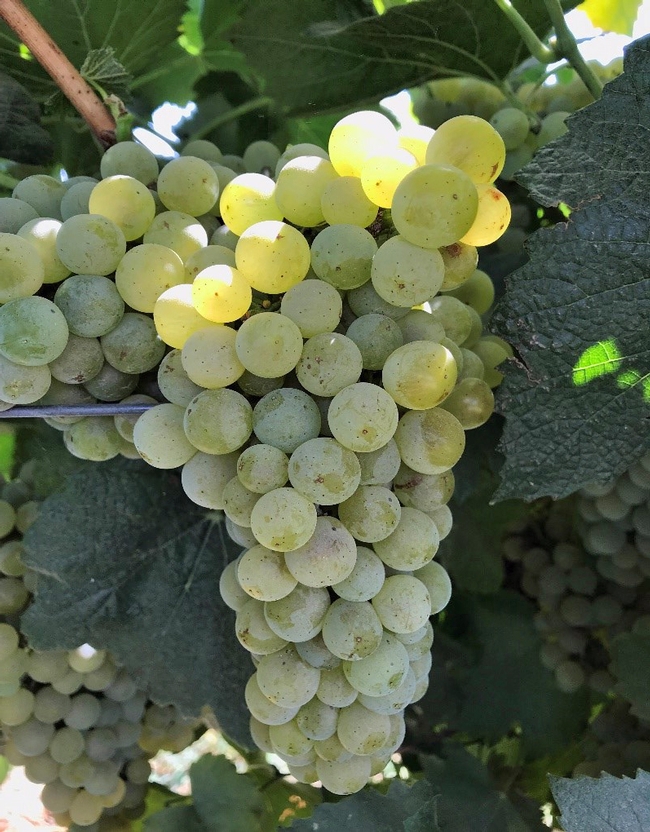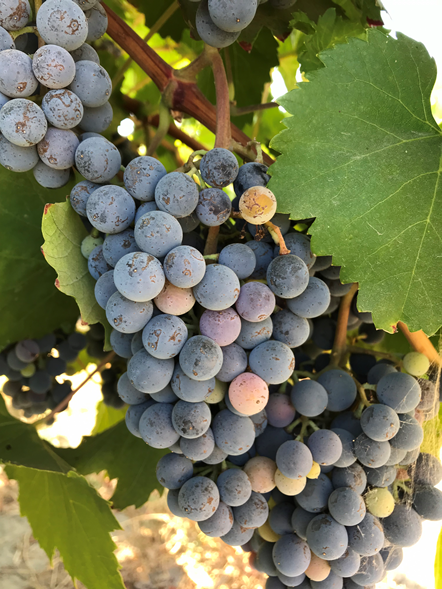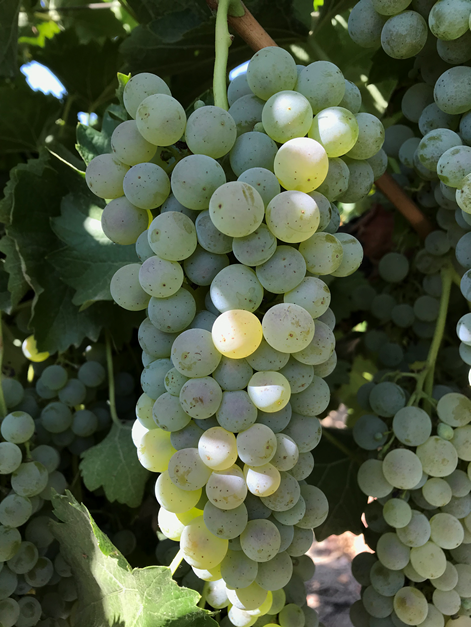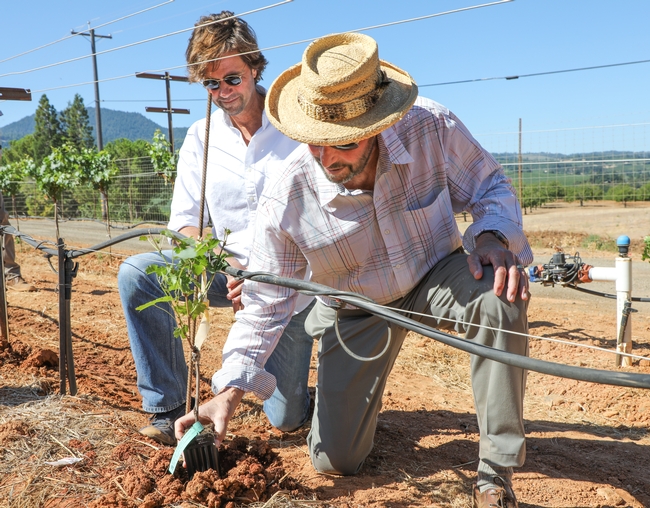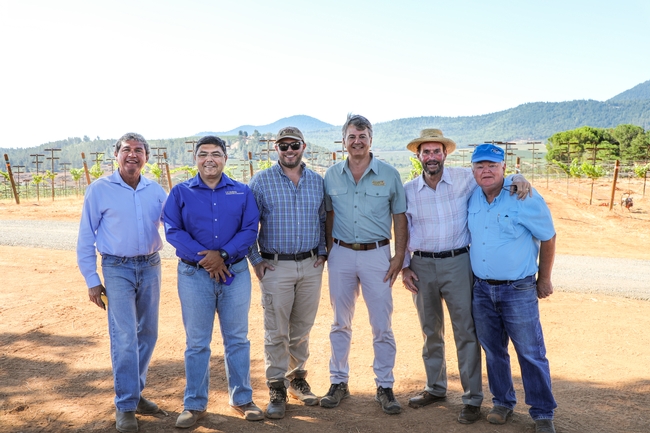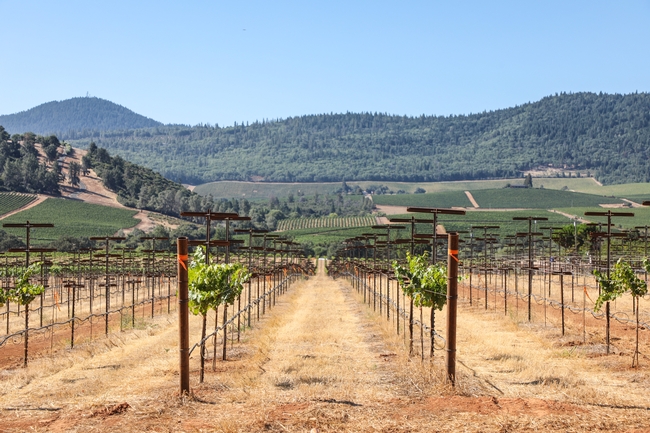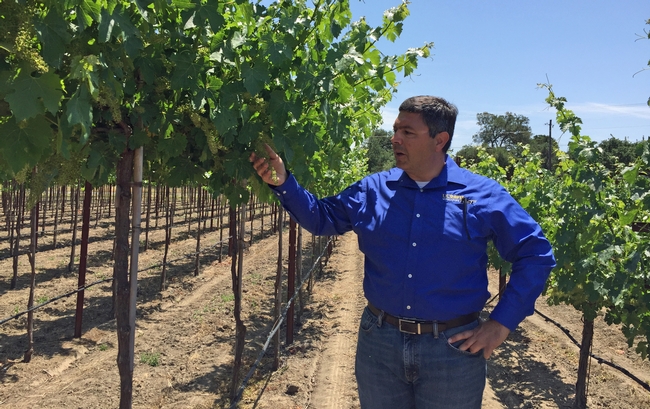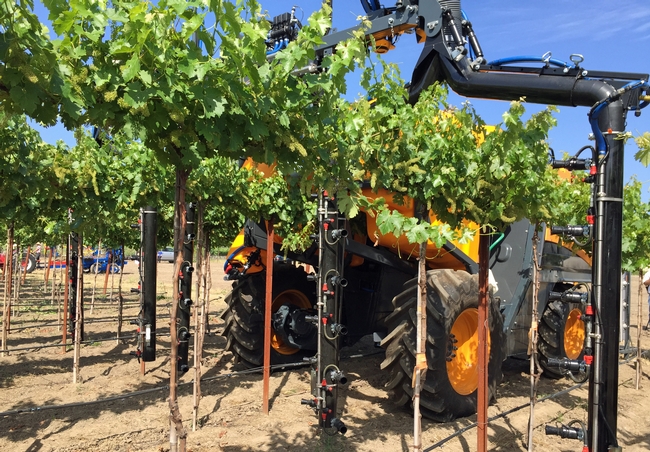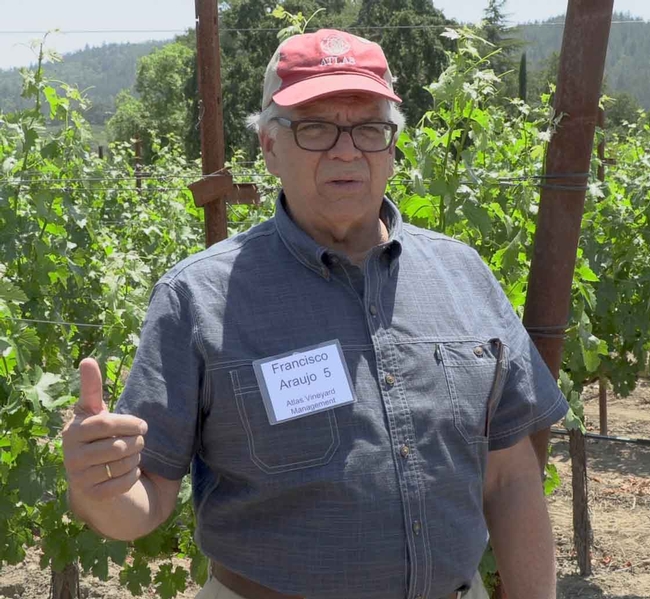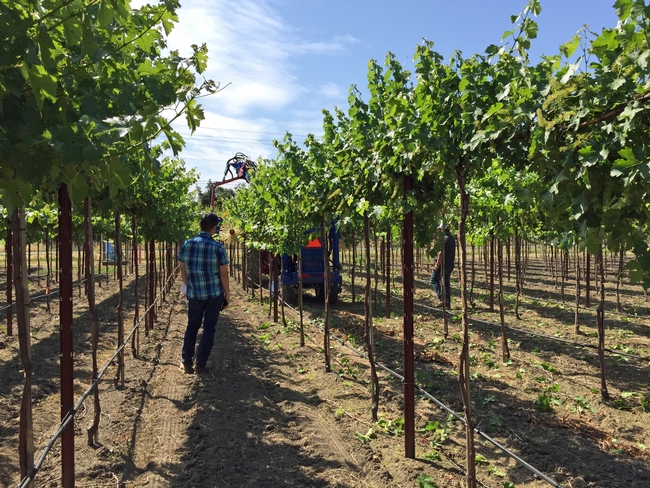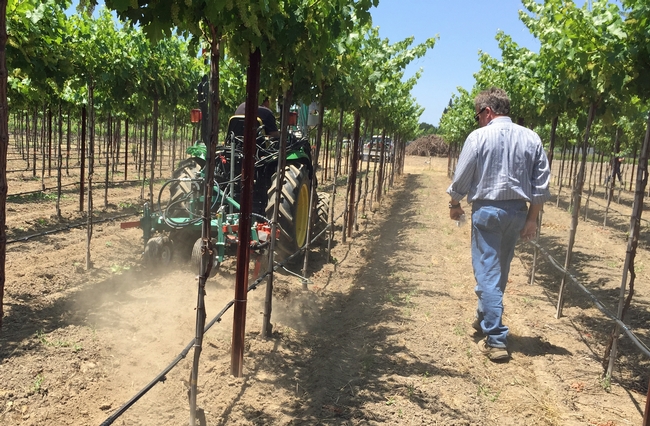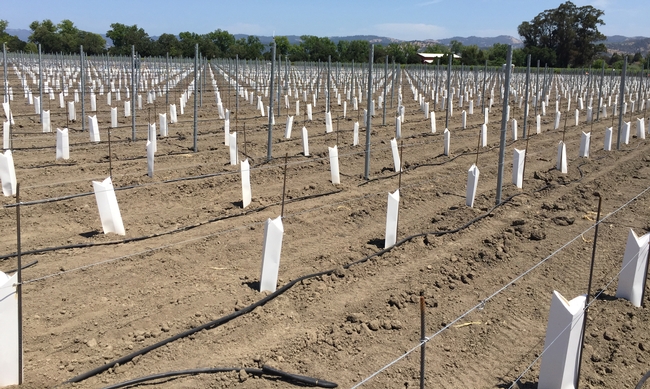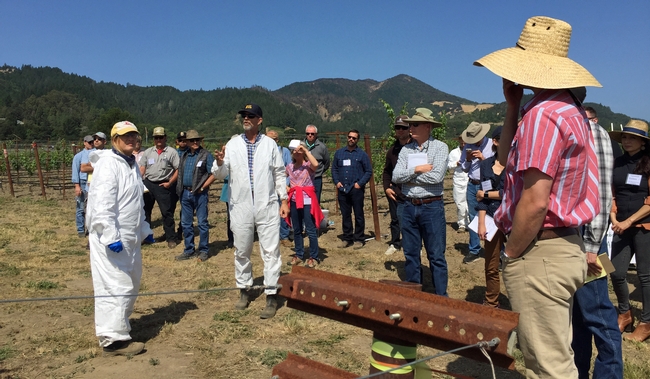Posts Tagged: Kaan Kurtural
Coastal grape growers can use less water during drought
Study finds using less doesn't compromise quality
California grape growers in coastal areas can use less water during times of drought and cut irrigation levels without affecting crop yields or quality, according to a new study out of the University of California, Davis.
The findings, published today (Sept. 1) in the journal Frontiers in Plant Science, show that vineyards can use 50% of the irrigation water normally used by grape crops without compromising flavor, color and sugar content.
It sheds new light on how vineyards can mitigate drought effects at a time when California is experiencing a severe water shortage and facing more extreme weather brought on by climate change, according to lead author Kaan Kurtural, professor of viticulture and enology and an extension specialist at UC Davis.
“It is a significant finding,” Kurtural said. “We don't necessarily have to increase the amount of water supplied to grape vines.”
Growers will also be able to use this information to plan for the next growing season. “Everybody's worried about what's going to happen next year,” he said.
Kurtural and others from his lab studied irrigation and cabernet sauvignon grape quality at a research vineyard in Napa Valley over two growing seasons, a rainy one in 2019 and a hyper-arid one in 2020.
They focused on crop evapotranspiration, which was the amount of water lost to the atmosphere from the vineyard system based on canopy size. The weekly tests used irrigation to replace 25%, 50% and 100% of what had been lost by the crop to evapotranspiration.
Researchers found that replacing 50% of the water was the most beneficial in maintaining the grape's flavor profile and yield. The level of symbiotic arbuscular mycorrhizal fungi, which help grapevines overcome stresses such as water deficits, was also not compromised. And the water used to dilute nitrogen application was also reduced, making the process more environmentally friendly.
The water footprint for growing grapes also decreased. For both the 25% and 50% replacement levels, water use efficiency increased between 18.6% and 29.2% in the 2019 growing season and by 29.2% and 42.9% in the following dry year.
While focused on cabernet sauvignon, most red grapes will respond similarly, he said.
“In the end, drought is not coming for wine,” Kurtural said. “There doesn't need to be a tremendous amount of water for grapes. If you over irrigate in times like these, you're just going to ruin quality for little gain.”
Members of Kurtural's lab — Nazareth Torres, Runze Yu, Johann Martinez-Lüscher and Evmorefia Kostaki — are also credited as authors.
University of California Agriculture and Natural Resources provided partial funding.
For more information, contact:
- Kaan Kurtural, Viticulture and Enology, skkurtural@ucdavis.edu
- Amy Quinton, UC Davis News and Media Relations, amquinton@ucdavis.edu
- Emily C. Dooley, College of Agricultural and Environmental Sciences, ecdooley@ucdavis.edu
Machines can help wine grape industry survive labor shortage
Wine grape growers in California and elsewhere face increasing labor costs and severe labor shortages, making it difficult to manage and harvest a vineyard while maintaining profitability. Growers are increasingly turning to machines for pruning, canopy management and harvesting, but how well these practices are executed can substantially affect yield and quality. A new review by researchers at the University of California, Davis, published in the journal Catalyst, provides guidelines for growers to make the best use of machines.
“Wine grape laborers have been virtually nonexistent. People don't want to work in vineyards anymore because it's remote, tough work,” said Kaan Kurtural, UC Davis professor of viticulture andenology andUC Cooperative Extension specialist. “There is now machinery available to do everything without touching a vineyard.”
Kurtural has designed a “touchless” experimental vineyard at the UC Davis Oakville Station to help growers understand how machines can help them cope with the labor shortage. While machines reduce the need for seasonal manual labor, they do not eliminate it. The degree of labor reduction depends on growing region, grapevine type and the number of practices growers mechanize.
The review provides guidance on using machines for winter pruning, canopy management and harvesting as well as how to design a grape vineyard for machines before planting. Videos showing the operation of different types of machinery and practices can also be found in the review.
Economic savings, quality grapes
About 90% of the wine grapes crushed in the U.S. are mechanically harvested. Previous studies have found about a 50% savings in labor costs from using machines to harvest instead of hand harvesting.
“Using more mechanization in a vineyard beyond just harvesting can also reduce labor costs without affecting grape quality.” Kurtural said.
Mechanical pruning, for example, can save between 60% to 80% of labor operation costs per acre compared to manual pruning alone. One experiment in the San Joaquin Valley, where more than 50% of California's wine grapes are grown, also showed using mechanical canopy management machines to manage merlot grapes resulted in twice the amount of color. The more color, or higher anthocyanin concentrations, the better the quality. It can significantly improve returns from vineyards in California's heartland.
Kurtural said there are machines available to manage canopies, including machines for leaf removal, shoot thinning and trunk suckering. Kurtural noted that the machines are American made, developed by researchers at the University of Arkansas and commercialized by manufacturers in Fresno and Woodland, California.
The review was co-authored by Matthew Fidelibus, UC Cooperative Extension viticulture specialist at UC Davis, based at UC Kearney Agricultural Research and Extension Center. Financial support for the research came from the American Vineyard Foundation and Bronco Wine Company.
Original post at https://www.ucdavis.edu/news/machines-can-help-wine-grape-industry-survive-labor-shortage.
UC releases new cost studies for mechanized winegrape production
New studies provide details about trellis type, planting density, cost and potential benefit of vineyard mechanization
UC Agriculture and Natural Resources' Agricultural Issues Center has released four new studies detailing the costs and returns of wine grape production in the southern San Joaquin Valley. All four cost studies illustrate the cost and benefit of nearly full mechanization on wine grape production.
The studies estimate the cost of establishing a vineyard and producing wine grapes, focusing on four wine grape varieties – Cabernet Sauvignon, Chardonnay, Rubired and Colombard.
“Those studies take into consideration mechanical pruning, leafing, shoot thinning, and harvest on a typical wine grape vineyard with the average production level for this region,” said George Zhuang, UC Cooperative Extension viticulture advisor in Fresno County.
“With farming labor becoming more scarce and expensive, growers will opt to transition into more mechanization,” Zhuang said. “These studies provide detailed information about the trellis type, planting density, cost and potential benefit of vineyard mechanization. Based on these studies, fully implemented mechanization reduces the production cost from $3,000 to $2,500 per acre and that represents 17% cost reduction. This information will ultimately help growers to guide their production practices to more profitable and competitive ways under the new era of farming labor.”
Wine grape growers should look at the costs, particularly expenses associated with mechanization, Zhuang said.
“The investment to purchase and own equipment can be high,” Zhuang said. “Fortunately, it is easy to find a contractor in this region to perform certain vineyard tasks, if the initial investment to purchase equipment is prohibitive.”
Numerous studies, including UC studies, have confirmed the benefits of vineyard mechanization to grape and wine quality with lower production costs.
“It is a win-win-win situation,” Zhuang said. “Growers can improve their farming margins, wineries and juice processing plants can get reliable and higher quality grapes and juice from farms, and average consumers can enjoy better wine and more healthy grape products at an affordable price.”
The studies are based on 200-acre farms with the vineyard established on 40 acres using two types of trellis systems – quadrilateral cordon system and bilateral cordon system. In addition to regular grape production expenses – such as irrigation, fertilization and pest control – the researchers broke out the differences between machinery costs and hand labor hours required for thinning, pruning and harvesting for each variety.The prices for labor, materials, equipment and custom services are based on October 2019 figures.
The California minimum wage law will gradually decrease the number of hours employees can work on a daily and weekly basis before overtime wages are required. For more information and to view the California minimum wage and overtime phase-in schedules visit aic.ucdavis.edu.
Input and reviews were provided by UC Cooperative Extension farm advisors, specialists, grower cooperators and other agricultural associates. The authors describe the assumptions used to identify current costs for wine grape establishment and production, material inputs, cash and non-cash overhead. A ranging analysis table shows profits over a range of prices and yields.
The new studies are:
- 2019 - Sample Costs to Establish and Produce Winegrapes in the Southern San Joaquin Valley – Chardonnay Variety
- 2019 - Sample Costs to Establish and Produce Winegrapes in the Southern San Joaquin Valley –Cabernet Sauvignon Variety
- 2019 - Sample Costs to Establish and Produce Winegrapes in the Southern San Joaquin Valley – Rubired Variety
- 2019 - Sample Costs to Establish and Produce Winegrapes in the Southern San Joaquin Valley – Colombard Variety
All four winegrape studies can be downloaded from the UC Davis Department of Agricultural and Resource Economics website at http://coststudies.ucdavis.edu. Sample cost of production studies for many other commodities are also available on the website.
For additional information or an explanation of the calculations used in the studies, contact Donald Stewart at the Agricultural Issues Center at (530) 752-4651 or destewart@ucdavis.edu.
For information about local grape production, contact George Zhuang, UCCE viticulture advisor for Fresno County, at gzhuang@ucanr.edu; UCCE viticulture specialist Matt Fidelibus at mwfidelibus@ucanr.edu; UCCE viticulture specialist Kaan Kurtural at skkurtural@ucdavis.edu; Karl Lund, UCCE viticulture advisor for Madera, Merced and Mariposa counties, at ktlund@ucanr.edu; or Gabriel Torres, UCCE viticulture advisor for Kings and Tulare counties, at gabtorres@ucanr.edu.
To save cabernet from climate change, UC studies rootstock and clone combinations
UC Cooperative Extension, Beckstoffer Vineyards and Duarte Nursery are launching the wine industry's most ambitious cabernet sauvignon rootstock and clone trial in the Red Hills of Lake County to give the varietal greater resilience to climate change.
Cabernet sauvignon is California's second top-selling varietal by volume, just behind chardonnay.
“We have been growing cabernet sauvignon since the 1970s, and we are very proud to be part of this trial, which will help improve cabernet sauvignon growing for years to come,” said Andy Beckstoffer, owner and CEO of Beckstoffer Vineyards, which is providing the land and labor for the project.
The industry-driven trial – “Climate-smart Solutions for Cabernet Sauvignon Production” – includes 3,600 vines with 10 cabernet sauvignon clones on 10 rootstocks.
“This trial will give us data that will help inform and improve growing practices for cabernet sauvignon across the state for the next two decades,” said the trial's lead researcher, S. Kaan Kurtural, UC Cooperative Extension viticulture specialist at UC Davis Department of Viticulture and Enology and Oakville Experiment Station.
While the experimental vineyard is in Lake County at a property known as Amber Knolls, the data will be analyzed in Oakville.
The trial officially launched Aug. 15 in Kelseyville with a celebratory vine planting as Andy Beckstoffer and son David Beckstoffer planted the vine that also marked a milestone – the 1.5 millionth vine for Beckstoffer Vineyards Red Hills. Researchers, industry representatives and journalists gathered to celebrate what is affectionately known as “the mother of all cabernet trials.”
“Everything is wonderful in Lake County – for growing cabernet sauvignon and for doing research,” Andy Beckstoffer said, noting the Lake County region's ongoing support for farming.
Pedro Rubio, Beckstoffer Vineyards Red Hills general manager, said, “Lake County will definitely benefit, but the results from this trial will be very helpful for the whole industry.”
Designed to address resiliency in a changing climate, the trial will examine which combinations give the best results with a focus on drought tolerance and water-use efficiency as well as crop yield and grape quality.
“The idea behind the trial is to gain further insights into the interactive effects of rootstock selections crossed with cabernet clones and the impact of that on water relations and overall sustainability,” said Clint Nelson, ranch manager for Beckstoffer Vineyards Red Hills.
“The trial will give us an understanding of the synergistic relationship of clone and rootstock and what combination drives the best quality and production,” he said.
According to Nelson, the trial will look at canopy architecture, yield components, water relations, traditional fruit chemistries, secondary metabolites such as aroma, mouthfeel and color, as well as overall vine performance.
Duarte Nursery is providing all of the planting material for the trial.
“The diversity of rootstocks and clones chosen for this project includes some of the most modern cabernet sauvignon clones designed for high quality and for production,” said John Duarte, nursery president.
Duarte said the trial is employing a lot of cutting-edge technology and using some of the cleanest plant materials available to prevent grapevine viruses.
“Planting a vineyard with pristine nursery stock initially really extends the life of that vineyard,” Duarte said.
Viticulture has become more data-driven, and this trial will measure a staggering amount of data generated by the 100 or so rootstock-clone combinations over the approximately eight to 10 years of the trial's duration.
“Nothing of this scope has been attempted,” said UC Cooperative Extension specialist Kurtural, who acknowledged logistics as the biggest challenge with planning, data collection and timely analysis being at the forefront of his mind. “It keeps me up at night.”
Planning for the length of the project also is a concern. The vineyard will be planted this year and the first crop will be harvested in 2021. It will take at least six years to begin to see consistent results.
Kurtural said the project will provide research opportunities in academic and applied science for at least two students to complete work toward a doctoral degree in horticulture and agronomy.
Glenn McGourty, UC Cooperative Extension viticulture advisor for Lake and Mendocino counties, is a research collaborator on the project.
“Lake County obviously has an important role to play in fine wine in the North Coast, particularly for cabernet sauvignon,” McGourty said. “And this trial really marks the importance of this location in terms of the commitment and the collaboration that we see here among both public and private sectors.”
About Beckstoffer Vineyards: Named “Napa's most powerful grape grower” by both the Wall Street Journal and Wine Spectator, Beckstoffer Vineyards was founded in 1970. Beckstoffer Vineyards is firmly rooted in the soil of Northern California's wine country, with Andy Beckstoffer playing an integral role in the evolution of the wine grape industry since 1970. Joined at the family-owned business by his son David in 1997, they share a common mission – to produce the highest quality grapes in Northern California that form the foundation for exceptional wines – and a combined passion for the land and viticulture expertise. Beckstoffer Vineyards first acquired land in the Red Hills in 1997, which after subsequent acquisitions, today totals nearly 2,000 planted acres across three blocks: Amber Knolls Vineyard, Crimson Ridge Vineyard, and Amber Mountain Vineyard.
About Duarte Nursery: Duarte Nursery, Inc. (DNI) is a family-owned and operated nursery and the largest permanent crops nursery in the United States.
Growers get labor-saving ideas at UC Grape Day
Will machines replace the romance of the hand-cultivated wine grape vineyard? A “touchless” vineyard was among the latest research on labor shortages, weeds and pest management by UC Cooperative Extension scientists discussed at Grape Day at the UC Davis Oakville Station, located in the epicenter of California wine country, on June 6.
About 200 wine grape growers, vineyard consultants and other industry people attended to learn about the latest UC Cooperative Extension research. Vineyard managers from boutique wineries such as Fork in the Road to Pine Ridge Vineyards to the Fortune 500 wine company Constellation Brands gathered at the research station's experimental vineyard. Several vineyard equipment representatives brought their machines to the field to demonstrate their weeding, pruning and canopy management capabilities.
Addressing labor shortages
To help growers attract and retain farm workers, Monica Cooper, UC Cooperative Extension advisor for Napa County and her research assistant, Malcolm Hobbs, are conducting a survey of agricultural workers to determine the factors that affect job satisfaction. They found the number of female workers in Napa County has increased rapidly since 2013. “Women may be moving into the labor pool to fill vacancies caused by the decline in the number of male workers migrating to the U.S. for agricultural work,” Cooper said.
They plan to provide participating companies with custom recommendations for recruiting and retaining workers.
“We will also be generating a generic summary that will be widely shared with participants and non-participants at the close of the study. For now, we cannot make any general conclusions or recommendations because data collection is ongoing,” Cooper said. “We are aiming to distribute our final report this winter, so stay tuned.”
To help growers reduce their need for hand labor, UC Cooperative Extension viticulture specialist Kaan Kurtural designed a “touchless” demonstration vineyard that is mechanically managed. The mechanized vineyard is one of six trellis systems he is studying for water use, nitrogen use efficiency, yield and fruit quality of the wine grapes.
“We're always looking for ways to improve yield, quality and to reduce cost,” said Francisco Araujo, director of viticulture for Atlas Vineyard Management. “In light of the labor shortage we're facing right now, Kaan is exploring new production systems that include new trellises, mechanization, different types of mechanization from pruning to shoot thinning and trunk suckering. He's obtaining information about how these new trellis systems that he is investigating are going to play with yield and quality.”
The touchless vineyard experiment started out as a demonstration at first, but with grower interest, it turned into a full-blown research project.
“It started as way of saving labor costs, but when we started looking at the physiological aspects of how these plants grow, we saw the benefits from the quality point of view in addition to the labor savings,” said Kurtural, who is based in the Department of Viticulture and Enology at UC Davis.
A traditional vineyard in the Napa area is about a meter or 36 inches above the vineyard floor with vertical shoots held up with wires, which are moved by hand.
Saves water
“We said, ‘Why don't we turn the system upside down?' Grow a tall trunk then put the bilateral cordon about 62 inches above the vineyard floor, that way we can push the rows a lot closer,” said Kurtural, who oversees the 40-acre Oakville experimental vineyard. The leaves grow down to generate the same leaf area as a traditional vineyard, but the leaves in the mechanized vineyard use water more efficiently so the no-touch vineyard requires less water compared to traditional vineyard systems.
“This is a dense system, this is 1.5 meters by 2 meters, roughly 1,340 plants per acre – we're getting by here on a third to quarter acre foot of water,” Kurtural said.
“It costs us roughly about a dollar in labor operation costs to manage each plant in a traditionally farmed vineyard of roughly about 1,300 plants per acre on the North Coast now,” Kurtural said. “The no-touch plants are costing us about 7 cents in labor operations costs.”
“The biggest expense is pruning, after that we go through what they call trunk suckering, which is also done mechanically here, and after that they will do shoot removal to open up the canopy. That's also done mechanically. After that, if there's need, they will do leaf removal, that's also done mechanically. And one last resort, if there's too much crop here, they will shake off excess berries with a harvester.”
The conventional system yields up to 5 to 6 tons per acre whereas the mechanized vineyard yields 7 to 8 tons per acre.
“These clusters set far fewer berries than a traditionally managed vineyard, but the berry size is also very small, which is what the winemakers like,” he said.
During harvest, grapes picked by machine are sorted on board the harvester so they go into the winery in uniform sizes, whereas hand-harvested grapes have to be sorted on a tray before they are put into the press tank.
“We made wines from these last year and compared to our traditionally farmed vineyards. Until we tell people what it is, they cannot distinguish the quality of the fruit or the wine.”
Weed and pest management
John Roncoroni, UCCE weed science farm advisor in Napa County, discussed options for weed control among young grape vines.
In the past, many vineyards were fumigated before planting for disease control, but it also provided weed control for young vines.
“With the loss of most fumigants for use in vineyards, hand-weeding was often used to accomplish this task,” Roncoroni said. “Increased costs and decreased labor force have made hand weeding impractical. Mechanical cultivation, at this point, is too imprecise – either leaving weeds close to young vines or causing damage by being too close.”
Covers on young vines allow the use of many post-emergence herbicides to control weeds, but Roncoroni cautioned that application of post-emergence herbicides on vines that aren't protected by mature bark may damage or even kill the vine.
“Herbicide use on vines less than 3 years old is a risky endeavor,” Roncoroni said. “Follow all label requirements, paying special attention to soil and irrigation recommendations.”
Lynn Wunderlich, UC Cooperative Extension advisor for the Central Sierra, and Franz Niederholzer, UC Cooperative Extension advisor for Colusa, Sutter and Yuba counties, demonstrated how to calibrate sprayers and to get uniform coverage when spraying fungicides.
In 2016, UC Davis researchers identified the three-cornered alfalfa hopper, Spissistilus festinus, as a vector of grapevine red blotch virus. Cindy Preto, a Ph.D candidate in the UC Davis Department of Entomology who is assisting UC scientists studying the three-cornered alfalfa hopper's biology and host plants, provided an update on their research.
Araujo, the viticulture consultant, said he and his colleagues value the university's research. “Napa Valley is a place where quality is paramount yet more and more we have labor shortage, we have inflation, production costs are going up,” he said. “Finding a way to get maximum quality along with yield levels that will pay for the increasing costs of production is the only way we'll be sustainable now and in the future.”


